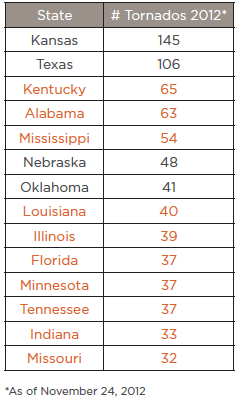2012 was a year of natural catastrophes. From Hurricane Sandy to the record-setting drought to the third most destructive wildfire season on record, the year was fraught with disasters that took a toll not only on communities nationwide, but on some of the world’s largest insurers. Today, CoreLogic issued its annual Natural Hazard Risk Summary, which details the most significant natural disasters that struck the United States in 2012. It notes the following:
Hurricanes
- The single most destructive natural disaster in 2012 was Hurricane Sandy. In late October, the Category 1 storm generated record levels of storm surge along the northern New Jersey coast and in the New York City area, impacting more than five million residents across the region.
- The first hurricane to make landfall in the U.S. in 2012 was Category 1 Hurricane Isaac in late August, which caused an estimated $2 billion in insured losses around the New Orleans metro area.
Floods
- Flood losses are expected to total approximately $10 billion in 2012, which would result in the third consecutive year of increasing flood damage in the U.S.
- Earlier in the year, Tropical Storm Debby tracked slowly across the Florida peninsula in June, dropping at least 25 inches of rainfall along its path.
- After months of sustained, widespread drought, Hurricane Isaac brought heavy rainfall and flooding to Louisiana in late August before continuing northward into the Midwest.
Wildfires
- The 2012 wildfire season was the third most destructive on record in the U.S. in terms of total acres burned as of early December.
- The 15-year trend of fewer, but larger fires continued into 2012 with fewer than 51,000 individual wildfires across the country—the lowest number recorded since 1989.
- Several of the individual fires that occurred in 2012 set records, including Colorado’s Waldo Canyon Fire, which damaged or destroyed 346 homes, and New Mexico’s Whitewater-Baldy Fire, which burned more than 297,000 acres.
- NOAA continues to predict a pattern of drought conditions through the start of 2013, suggesting the potential for another increase in wildfire risk across much of the country.
Tornadoes
- Tornado activity in 2012 was not strictly limited to the region commonly referred to as “Tornado Alley.” States located outside the central and southern Great Plains experienced a significant number of tornadoes this year. The chart below, from CoreLogic’s report, represents states with 30 or more tornadoes in 2012. States in orange are not typically considered part of “Tornado Alley.”
- January 2012 was one of the most active Januaries since recording began in 1950, with a total of 79 tornadoes reported across the country.
- In late February, tornadoes struck Illinois, Indiana, Kentucky and Ohio. Harrisburg, Ill., experienced the most concentrated destruction, with more than 225 homes and businesses damaged or destroyed and an estimated $475 million in total damage.
“Because the strength, severity and geographic impact of natural disaster events will change from year to year, an understanding of patterns in hazard activity, geographic vulnerabilities and the properties exposed to each different type of disaster is crucial to managing risk,” said Dr. Thomas Jeffery, senior hazard scientist for CoreLogic.
As we’ve seen with the natural catastrophes of 2012, it is important for insurers, homeowners and businesses to develop a more comprehensive evaluation of risk — one that includes typically non-traditional locations.


 />i
/>i



